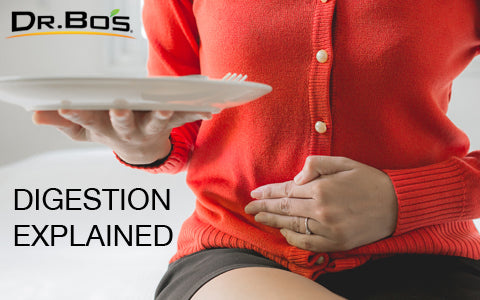Digestion is the process by which the complex materials of food are broken down into simpler substances in preparation for their entrance into the bloodstream. For example, proteins are broken down into various amino acids; carbohydrates, composed of starches and sugars, are converted to glucose, a simple sugar; and fats are broken down into new tissue. Let’s look at this process in more detail.
Three Steps to Digestion
Step 1: The Mouth
The human digestive tract is divided into three cavities: the mouth, the stomach and the small intestine. When food enters the mouth, it’s masticated and mixed with saliva, initiating the digestive process.
Appropriate digestive juices are also secreted here, according to the type of food ingested. If the food contains starch, then the enzyme amylase is also secreted. This enzyme is active only in the presence of starch and will not be secreted otherwise.
Step 2: The Stomach
After leaving the mouth, food passes down the esophagus and into the stomach. Here, gastric juice is secreted, containing primarily hydrochloric acid and digestive enzymes. The concentration of hydrochloric acid varies, again depending on the type of food ingested. Protein requires a highly acidic medium for the digestive enzyme pepsin, to be effective.
Starches and fats, however, require a nearly neutral medium for their digestion. In fact, salivary amylase is actually destroyed in the presence of highly acidic gastric juices, and the enzyme, gastric lipase, secreted for fat digestion, is also inhibited in its work in the presence of a highly acidic medium. These distinctions represent a significant factor in complicated digestion.
Step 3: The Intestines
The next factor to consider is this: each cavity contains its own distinctive digestive secretions with which to carry out its own specific work of digestion. And at each stage of this process, digestion proceeds more or less efficiently, depending upon the conditions present at each stage.
In other words, the efficiency of digestion in the intestines is dependent upon the work done in the mouth and stomach. It is a sequential operation. For example, if pepsin, the enzyme secreted in the stomach during the first stage of protein digestion, has not converted these proteins into peptones due to unfavorable conditions present in the stomach, then erepsin, the enzyme secreted in the intestine, will not be able to carry on the final stage of protein digestion, that of converting the peptones into amino acids. Each stage of digestion must not be interfered with if we desire efficient digestion.
Be sure to take Digestive Enzymes with every meal to aid this process and help support the breaking down of foods to absorb the most nutrients possible.


1 comment
Thank you for that. It helps explain why Dr Bo says to mix or not mix foods at a certain time. I will pass this on.